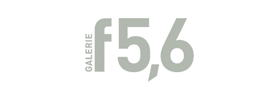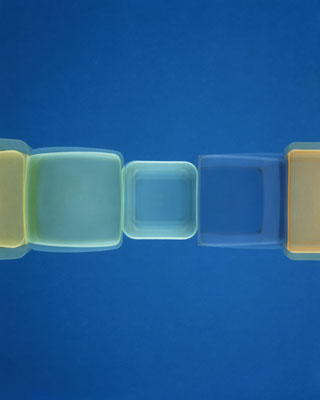
Untitled # 118, 1999
Richard Caldicott »
Exhibition: 21 Apr – 9 Jun 2007
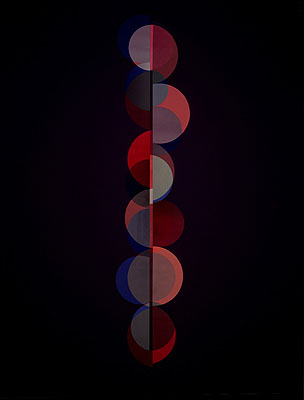
The early work of Richard Caldicott is in dialogue with the tradition of the photographic still-life and its reference into abstract painting. His objects of plastic everyday day Tupperware are taken out of its context and are canonised into the realms of 60's abstract art in a post modern , humorous manner. As Christopher Schreier writes: "Of a quite commanding, space-impinging presence, their dispute with painting, however, lies on a different, non-metric level. Even a first impression reveals the painterly qualities of his art. what we take in is summed up in a phrase Eugene Delacroix once coined for painting, namely "sensations colourantes", the visual sensations that seem sufficient unto themselves and the eye of the beholder. We may be tempted to regard these pictures purely for pleasure, and indeed the works' subtle play of colour and form suggests this response. Caldicott's works cultivate an aestheticism that makes the viewer almost forget that these photographs possess an outside reference. Seen purely as motifs, they go back to an inventory of plastic dishes or containers, mostly Tupperware, that in the early and mid-nineties Richard Caldicott piled up into imposing plastic structures. Although one might identify an individual salad bowl or lemon squeezer, the total form possesses a sef-referentiality that Caldicott has developed in later years. The ironic contrast between an apparently modernist-constructivist sculpture and the reality of its trivial, everyday substance, is no longer really the issue. It may have been a sign of (English?) humour, but Caldicott's art has always meant to be earnest. His concern is the metamorphosis of the everyday, which for him has something almost alchemical about it. This unquestionably goes one step further that photography's chemical transformation of reality into two dimensional pictures at the touch of a button. The works show that he is aiming for a kind of transmutation of the functionality and entity of everyday objects in to two dimensional pictures at the touch of a button. The works show that he is aiming for a kind of transmutation of the functionality and entity of everyday objects into the shimmering presence of simple translucent forms" In His newest series of work Caldicott completely leaves the realm of the photographic object and deals directly with abstraction in itself. Daniel Buren maintained that "colour is the most interesting thing in art because it is the only thing you cannot speak about". It is with this in mind that one should look at Caldicott's work. Working from collages and assemblages and then photographed stringently, by different techniques and presented as a photographic object in itself, his work has evolved, where. the object as subject has disappeared altogether, leaving only what were formerly colour backgrounds arranged in abstract, geometric compositions that constitute autonomous objects in their own right. In his images the collage, however, is never 'stuck down' it is only the process of photographing it that fixes the final result into an object. Derek Horton writes: "It is significant that Caldicott refers to his latest works as "Constructions", a term that simultaneously suggests the manual making of things and a connection to constructivism and architecture. Furthermore there is also a direct link to the minimal art era and Donald Judd's Specific Objects , "holistic and unified art objects that are neither painting nor sculpture" For its maker and viewer alike, Caldicott's art involves looking back into constructivist art and modernist design, referencing its purity of form and, by indirect allusion at least its utopian agenda...Whilst his work may suggest that Caldicott is an 'unreconstructed modernist', it is arguable that it is impossible now to make work 'as' a modernist – one can only refer to modernism or to use a term beloved of post modern theorists 'cite it'. For much post modern art such citation relies on pastiche that critiques or even lampoons modernism and its values., but for some artists of Caldicott's generation, who were exposed to post modern pastiche at its peak in the 1980's, it is possible now to look back to modernism from a different perspective, to be outside it but remain in many ways respectful or admiring of it" (Derek Horton Seeing through Modernism: Transparency, absence, construction) Richard Caldicott (b 1963 in Leicester) studied at the Royal College of Art in London where he also lives and works. He has had many solo and group exhibitions in Europe and the US and is represented in the following collections: Art Lab, Tokyo, Karl Blossfeldt/Albert Renger Patzsch Archiv, Kunstmuseum Bonn, Merril Lynch, Sir Elton John Collection, BP Amoco etc.
Die Galerie f5,6 zeigt eine Ausstellung des gebürtigen britischen Künstlers Richard Caldicott (geb. 1962). Seit mehr als 15 Jahren beschäftigt sich Caldicott mit dem künstlerischen Raum zwischen Fotografie, Malerei und Skulptur und betritt mit diesem Prozess immer wieder neue spannende Wege. Diese sind höchst komplex und oft schwierig zu beschreiben, da im postmodernen Sinne alle Tore geöffnet sind und der Betrachter gezwungen wird, einen anderen, neuen Dialog zu schaffen. Die Ausstellung spannt einen Bogen von seinen frühen Fotografien bis zu den jüngsten Arbeiten. Zum ersten Mal werden auch Zeichnungen und Kollagen gezeigt, die die Grundlage für Caldicotts Fotografien bilden. Der Entstehungsprozess und dessen Hinterfragung ist bei Caldicott ein zentrales Thema. Kunstgeschichtlich stehen seine Arbeiten in einem Dialog mit der von Donald Judd bezeichneten Kategorie des "specific object": einem Objekt, das weder Malerei noch Skulptur ist und sich daher jeglicher Form von Kategorisierung entzieht. In seinen frühen Arbeiten baut Caldicott in einen leeren, aber farbigen Raum alltägliche Plastikobjekte, vor allem Tupperware, zu Skulpturen auf und fotografiert diese als reine, abstrahierte Form. Hier vereint er oft auf ironische Art das Duchamp`sche "ready made" (die Tupperware) mit der sogenannten sublimen amerikanischen Malerei der 60er Jahre (Kenneth Noland, Mark Rothko, Barnett Newman). Gleichzeitig beschäftigt er sich durch den Akt des Fotografierens mit dem Thema des fotografischen Stilllebens und dessen Geschichte, welche er durch das Fotografieren von alltäglichen, banalen Objekten weiterführt. In Caldicotts neuen Arbeiten wird die Fotografie noch weiter entleert und beinhaltet kein Subjekt oder Objekt mehr. Vielmehr besteht die Fotografie nur noch "aus einer Art Konstruktion" (Caldicott). Caldicott baut eigenständige "Skulpturen-Kollagen", meist aus Papier, zusammen und fotografiert diese. Hier wird nun die Fotografie an sich objektifiziert und zum eigenständigen Gegenstand erhoben. Gleichzeitig eröffnet sich durch diesen Prozess eine weitere Hinterfragung des Mediums Fotografie und die des "spezifischen Objektes". Darüber hinaus tritt Caldicott als postmoderner Künstler mit der vergangenen Epoche der Moderne in all ihren Facetten und Formen in Dialog. Aber nicht nur mit der abstrakten Kunst von Kasimir Malewitsch bis zum Minimalismus, sondern auch mit der simplen, strukturierten Rationalität der Architektur sowie der Musik der Moderne. Diese interdisziplinäre Idee ist wiederum in sich selbst der Ausgangspunkt von den Idealen des Bauhaus oder de Stijls, die Caldicott in seinen neuen Arbeiten aufgreift und weiterführt. Der Betrachter muss sich in Caldicotts Arbeiten in einen bildlich kontemplativen Raum begeben und wird eingeladen, eine neue Türe zu öffnen, welche aber wie in einem Labyrinth immer wieder neue Türen aufzeigt. Letztendlich wird der Betrachter auf sich selbst zurückgeführt. Caldicotts Arbeiten sind in vielen bekannten Öffentlichen Sammlungen vertreten: BP Amoco, Sammlung Ann und Jürgen Wilde, Sir Elton John Collection. , Goldman Sachs, Merryll Lynch, Kunstmuseum Bonn.
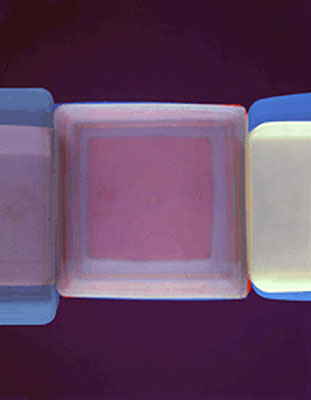
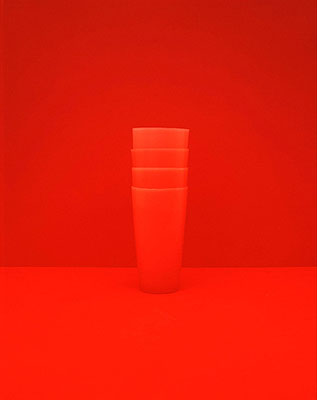
Beakers No. 2, 1994
